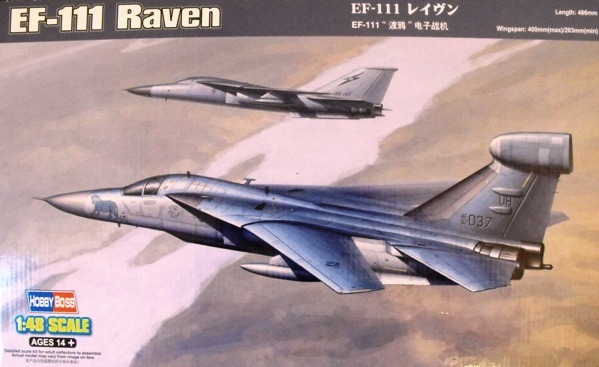Review By: Adam Brown

Background
In the late 1960s, the U.S. Air Force sought a replacement for the ageing EB-66 and EB-57 electronic warfare aircraft. The Air Force studied the use of Navy EA-6B Prowlers during 1967-68, though they desired a penetrating electronic jamming aircraft with supersonic speed. In 1972, the Air Force decided to modify the F-111As into electronic warfare aircraft as a cost-effective option.
In January 1974, the Air Force awarded electronic warfare study contracts to Grumman and General Dynamics. Grumman was selected as the EF-111 prime contractor in December 1974, then was awarded a contract to modify two F-111As into EF-111 prototypes in January 1975. The first fully equipped model, known then as the “Electric Fox”, flew on 10 March 1977, and deliveries to combat units began in 1981. A total of 42 airframes were converted at a total cost of US$1.5 billion, the last delivered in 1985.
The Raven retained the F-111A’s navigation systems, with a revised AN/APQ-160 radar primarily for ground mapping. The primary feature of the Raven, however, was the Raytheon AN/ALQ-99E jamming system, developed from the Navy’s ALQ-99 on the Prowler. Its primary electronics were installed in the weapons bay, with transmitters fitted in a 16 feet (4.9 m) long ventral “canoe” radome; the complete installation weighed some 6,000 pounds (2,700 kg).
Receivers were installed in a fin-tip pod, or “football”, similar to that of the EA-6B. The aircraft’s electrical and cooling systems had to be extensively upgraded to support this equipment. The cockpit was also rearranged, with all flight and navigation displays relocated to the pilot’s side, and flight controls except throttles being removed from the other seat, where the electronic warfare officer’s instrumentation and controls were installed.
The EF-111 is unarmed. The aircraft’s speed and acceleration were its main means of self-defense. The EF-111 was not capable of firing anti-radiation missiles in the lethal SEAD role, which was a tactical limitation. The EF-111A’s engines were upgraded to the more powerful TF30-P-9 of the D-model, with 12,000 pounds-force (53 kN) dry and 19,600 lbf (87 kN) afterburning thrust in 1986.
First Impressions
Click on image to enlarge.
.
This is the fifth in the series of the ‘Aardvark’ family released by HobbyBoss in the last year or so, and the most eagerly awaited by yours truly!
The kit comes in a very big and sturdy box absolutely crammed with plastic which has no flash and very few ejector marks, the only ones will be hidden away never to be seen again once the kit is built up.
As this is the unarmed electronic warfare variant of the Aardvark – or Sparkvark as it was commonly called by air and ground crew – there is no ordnance in the box. What you do get though is a sprue with 4 types of ECM pods which include the AN/ALQ-87 and AN/ALQ-131.
The new tail is presented on a sprue with the new Instrument Panel and underbelly electronics jamming bulge, the other 11 sprues (yes, 11!) contain all the other well detailed parts, including two full engines for those super detailers out there.
I have heard there are some inaccuracies with the HobbyBoss ‘Vark, but I’m sorry to say this to the rivet counters amongst you, I don’t really care as it looks every inch like an EF-111!!
The two main fuselage halves come in a separate box along with the clear parts and the rubber tyres (groan), but they don’t look that bad!
Decals and Instructions
Three decal sheets are provided allowing you to build two airframes, one being from RAF/USAFE Upper Heyford and the other adourning some piratey nose art from Cannon AFB USA. Both planes sport the two tone grey schemes which will be a weatherer’s heaven.
Instructions come in a really easy to follow booklet, unlike the awful instructions that came in their Tornado ADV kit!
Conclusion
My conclusion is that it’s not a cheap kit but if you do dish out the readies you won’t be disappointed. There is so much in the box and very little need for any aftermarket accessories so potentially it is ready to build now (hopefully I haven’t just shot myself in the foot!). This aircraft will sit up and beg for attention from oils and pastels when the need arises, but please be subtle! I expect these to be rife at model shows later this year.
Adam B.
Reference info taken from Wikipedia.













Tony Moclair says
Agreed. I built this kit (added long wings from Hobby Boss’ F-111C and made a ‘what if’ RAAF HARM-capable EF-111C). It’s a delightful kit that commands a fair amount of room on the shelf.